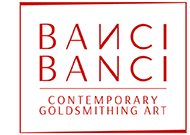L’architettura è uno degli elementi fondamentali della formazione e del percorso artistico di Daniela e Marzia Banci.
Tra le figure che hanno contribuito ad arricchire la mostra “La tradizione nella modernità” c’è Vittorio Spigai che entrambe hanno incontrato nel loro periodo universitario a Venezia.
Vittorio Spigai, toscano, è principalmente un pittore. Laureato in ingegneria a Roma con Vittorio De Feo e in architettura a Venezia con Carlo Aymonino, ha insegnato Composizione all’IUAV di Venezia dal 1971 al 2011. Come urbanista e architetto ha elaborato il piano regolatore di Trieste e numerosi grandi progetti tra cui il nuovo campus di Economia – Ca’ Foscari a Venezia, in corso di ultimazione nell’area dell’ex Ospedale Le Corbusier. Dal 2009 si sta dedicando al recupero e valorizzazione delle Mura Rinascimentali di Padova, mirabili e le maggiori integre al mondo.
Ecco l’estratto da una conversazione tra le orafe e l’architetto. Buona lettura!
Architetto e professore universitario, come si insegna il valore dello spazio?
Lo spazio in architettura non è riducibile a questione di spazio interno, non solo ad esso.
Essenziale è soprattutto il rapporto tra spazi interni dell’edificio e contesto esterno: le piazze e le strade, le visuali della campagna e della natura.
L’edificio chiuso in sé stesso, come un oggetto posato sul suo angusto appezzamento di verde, è il modello che ha distrutto le città europee dagli anni ’40 ad oggi e sconvolto i nostri territori.
La spazialità interna ha anch’essa valore ovviamente, ma questo valore viene moltiplicato quando interagisce con gli spazi pubblici della città, con i giardini, con il paesaggio.
Per fare un esempio a noi vicino, anche la più modesta delle ville venete – con la grande sala al piano nobile aperta verso un giardino o anche un semplice viale – era portatrice di questi valori.
Quale opera dell’architettura contemporanea rispecchia maggiormente i nostri giorni e perché?
Proprio per il modo – assolutamente temerario – in cui Jean Nouvel ha posto la necessità di un interazione tra edifico e il contesto del lago, della città e del paesaggio, credo che il KKL Concert Hall di Lucerna, inaugurato intorno al 2000, sia un’opera nobile.
Ma probabilmente non rispecchia i nostri giorni… di certo non l’attuale momento italiano, purtroppo; in cui un eccesso di normative e controlli ha reso quasi impossibile una buona architettura pubblica.
Abitare gli spazi delle case, della città, della cultura, del lavoro; come è cambiato nel tempo il progetto di questi luoghi?
La città e l’architettura sono l’impronta della società che le produce entrambe.
Nel passato – per qualsiasi edificio, pubblico o privato – una committenza colta non ammetteva edifici che non portassero un contributo all’immagine degli spazi pubblici e della città.
Oggi anche gli edifici più importanti sono degli sfregi alla cultura urbana del passato, alle tante attenzioni che una società profondamente civile si poneva nell’iniziare a costruire una fortificazione, un ponte, una casa, una fabbrica persino.
Pensiamo alla elegante e “urbana” architettura sociale e assistenziale dell’800 e del primo ‘900, per fare un esempio. Un tema scottante se guardiamo ai mostri dell’edilizia ospedaliera, nel nostro Veneto e in particolare nel centro di Padova, negli ultimi decenni.
Pittore e architetto: come e quando le due discipline si contaminano e quando invece rimangono felicemente diverse?
Non parlerei di contaminazione. Nel profondo, per ciò che conta, è la stessa identica cosa.
Le abilità necessarie sono diverse, ovviamente; ma possedendo le capacità per padroneggiarle entrambe dal punto di vista delle tecniche – il tipo di impegno è il medesimo.
L’architettura è forse più facile, meno acrobatica per così dire, perché una parte dei suoi contenuti è necessariamente oggettiva.
Mentre in pittura sei solo e il contenuto è quello che vuoi dire a te stesso e al mondo.
Si è a mani nude con una bestia che può scappare o far male, abbracciarti o deluderti in ogni momento.
Banci Banci, due orafe con la formazione dell’architetto: percepisci questo approccio in queste opere?
Nelle Banci vi è certamente un tratto comune che consiste nella ricerca continua di una ratio nell’ideazione e conduzione dell’opera. Che significa appunto progettualità.
Quello che sin dal primo giorno è il punto fermo in tutte le scuole di architettura. Ma che può rappresentare anche un laccio pericoloso.
Nel caso delle Banci la creatività fluisce libera, mentre il progetto porta rigore.
L’oreficeria è arte da indossare, nel nostro caso diventa anche un’estensione della propria personalità: è così intima anche la scelta degli spazi e dell’abitare?
Come dicevo, lo spazio della buona architettura non è solamente intimo e personale ma, al contrario e innanzitutto, si apre al contesto e alla collettività, diviene tramite.
Così il gioiello, anche se veste e aderisce intimamente al corpo, coinvolge chi lo osserva; che a sua volta ne è attratto come inconsapevole fruitore. Per questo motivo, quando un gioiello riesce ad attingere al livello di opera di scultura ha colto nel segno. E forse, da sempre, è questa la sfida per l’arte orafa. Esattamente come per l’architettura, una duplice intrinseca valenza: oggetto d’uso e soggetto di comunicazione.
Se ti chiedessero di realizzare un museo per il gioiello contemporaneo quali accorgimenti riterresti indispensabili?
Come per la pittura, anche per l’arte del gioiello non vorrei un museo del contemporaneo.
Sarebbe assai più avvincente far interagire gli splendori dell’oreficeria delle diverse epoche con il contemporaneo. Ricercando assonanze, comparazioni… ci sarebbero mille modi.
E nello stesso tempo far interagire il museo con la città. Per esempio, trovare delle idee per la compenetrazione tra spazi interni ed esterni, con accorgimenti di illuminazione e di sicurezza.
In modo che il museo non fosse chiuso in sé ma permeasse e arricchisse il quartiere, come una grande vetrina percorribile, per adornare la città. Insomma, non fermo nel suo secolo né chiuso nel suo palazzo.



